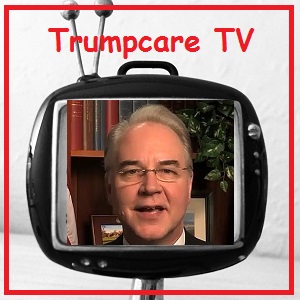
Trumpcare TV is now on air and hosted by Health and Human Services Secretary Tom Price.
Department of Health and Human Services Secretary Tom Price has issued a Request for Information from the general public on ways to weaken and water-down the Affordable Care Act. While the Request for Information does not commit HHS or Centers for Medicare and Medicaid Services (CMS) to propose any new rules from the public suggestions, it is very clear the RIF is a pre-text for advancing promoting rules that will weaken Obamacare further.
Public Comments To Support Weakening Obamacare
The main focus of the RIF is to gather unscientific an unsubstantiated public comments as a way to justify reducing the federal oversight of health insurance and return more control over to the states.
…to the maximum extent permitted by law, to afford the States more flexibility and control to create a more free and open health care market; provide relief from any provision or requirement of the PPACA that would impose a fiscal burden on any State or a cost, fee, tax, penalty, or regulatory burden on individuals, families, health care providers, health insurers, patients, recipients of health care services, purchasers of health insurance, or makers of medical devices, products, or medications; provide greater flexibility to States and cooperate with them in implementing health care programs; and encourage the development of a free and open market in interstate commerce for the offering of health care services and health insurance, with the goal of achieving and preserving maximum options for patients and consumers.” From page 3 of the RIF,
CMS is soliciting public comments or suggestions in four general areas.
1. Empowering patients and promoting consumer choice. What activities would best inform consumers and help them choose a plan that best meets their needs? Which regulations currently reduce consumer choices of how to finance their health care and health insurance needs? Choice includes the freedom to choose how to finance one’s healthcare, which insurer to use, and which provider to use.
2. Stabilizing the individual, small group, and non-traditional health insurance markets. What changes would bring stability to the risk pool, promote continuous coverage, increase the number of younger and healthier consumers purchasing plans, reduce uncertainty and volatility, and encourage uninsured individuals to buy coverage?
3. Enhancing affordability. What steps can HHS take to enhance the affordability of coverage for individual consumers and small businesses?
4. Affirming the traditional regulatory authority of the States in regulating the business of health insurance. Which HHS regulations or policies have impeded or unnecessarily interfered with States’ primary role in regulating the health insurance markets they know best?
CMS already knows the answers to these questions. They are just looking suggestions that they can cherry-pick from the responses so they can say, “Here is a great idea that the public wants and here is new rule supporting it.”
When it comes to empowering patients and consumer choice, the lack of any replacement to the ACA from congress for 2018 is causing health plans to pull out of the market, limiting consumer choice. Attempts to defund Planned Parenthood will limit choice for consumers. One item I don’t understand is what they mean when they refer to “finance” a consumer’s health care. Do they mean the type of subsidies that are offered or do they mean how to finance high consumer medical debt triggered by skimpy and cheap health insurance products they want sold.
The second question about stabilizing the risk pool is stunningly arrogant. The risk pool stability has already been sabotaged by Secretary Price and President Trump attempting to waive the individual mandate for having health insurance. Risk pools are regional and by plan. Consumers signing up for health insurance in California are in a different risk pool from individuals enrolling in Nebraska. The risk pool for a PPO plan is different from an HMO plan. The only national risk pool is Medicare. But what I assume they are looking for is the green light to allow stripped down major medical health plans with $20,000 maximum out-of-pocket amounts to be sold to consumers for less than $100 per month.
Enhancing affordability is the third subject question and dovetails with the previous question about stabilization and promoting continuous coverage. You enhance affordability one of three ways. The first option is to get everyone into the premium pool for comprehensive health insurance, which spreads the risk and lowers the rates. Second, you allow stripped down major medical plans with really high deductibles and maximum out-of-pockets. This lowers the rates because it reduces the potential that the health plans have to pay any claims. Finally, you discriminate against people with pre-existing conditions. If you don’t cover a people health challenges, which incurs claims, you lower the rates.
The final topic for public comments is how to allow the states to have more control over health plans that are eligible for the Premium Tax Credits. Inherent is the supposition that states have a better understanding of how to regulate health insurance than the federal government. This assumes that the human condition is different depending on which state you live in. A pregnant woman in Alabama needs the same pre-natal care as a woman in California. The states should have no role in restricting or defining what is covered in a health insurance policy because their residents are somehow different. They are not different.
If people were truly different by state, Medicare coverage would be different between states. It is not. Medicare beneficiaries have the same coverage benefits regardless of whether they live in South Dakota or Arizona. People under 65 years old should expect coverage benefits to be the same regardless of what state they live in.
Notably absent from any of the suggestion topics are directions about the federal government negotiating drug prices or the cost of health care from doctors and hospitals. One of the main flaws of the ACA is that it didn’t have any price controls. The cost of health care is a major component of increasing health insurance rates. If Medicare can set reimbursement rates on a regional level, why can’t CMS do the same thing for individual and family plans and small group plans?
The RFI is not a serious attempt at gathering comments on how to stabilize the health insurance markets across the country. Trump and Price have already set in motion the slow dismantling of regulations that kept the ACA markets relatively stable. This is a thinly veiled attempt to generate regulation gutting suggestions that will further destroy meaningful health insurance for Americans. I can guarantee that any real suggestions that would work to contain health care costs, which are the real driver of ever escalating health insurance premiums, will be ignored.
The Centers for Medicare & Medicaid Services (CMS) seeks public input on reducing the regulatory burdens of the Patient Protection and Affordable Care Act (PPACA)
FOR IMMEDIATE RELEASE June 8, 2017
The Centers for Medicare & Medicaid Services (CMS) today issued a Request for Information (RFI) seeking recommendations and input from the public on how to create a more flexible, streamlined approach to the regulatory structure of the individual and small group markets. Our goal through this process is to identify and eliminate or change regulations that are outdated, unnecessary, or ineffective; impose costs that exceed benefits; or create inconsistencies that otherwise interfere with regulatory reform initiatives and policies.
“We are looking for valuable feedback on how to change existing regulations in ways that put patients first, promote greater consumer choice, enhance affordability and return more control over healthcare to the States,” said CMS Administrator Seema Verma. “Through this step, CMS is asking consumers to send us innovative ideas that will help stabilize and strengthen the individual and small group health insurance markets.”
Consumers who have obtained coverage through the Exchanges are facing significant premium increases. A recent report issued by our Department of Health and Human Services states that the average premium in the 39 states using HealthCare.gov in 2017 increased from $232 in 2013 to $476 in 2017, which is a 105 percent increase. Consumers are also dealing with fewer plans to choose from and a continuous stream of issuers exiting the Exchanges.
The RFI follows steps CMS has already taken to help improve the health care system, including issuing the Market Stabilization Final Rule on April 18, 2017. This new rule will place downward pressure on premiums, limit special enrollment period abuses, and help to improve choices; while also reducing regulatory burden. The RFI will be open for public comment for 30 days.To view the Request for Information, please visit: https://www.federalregister.gov/public-inspection/
Request for Information From CMS on the ACA
https://s3.amazonaws.com/public-inspection.federalregister.gov/2017-12130.pdf


